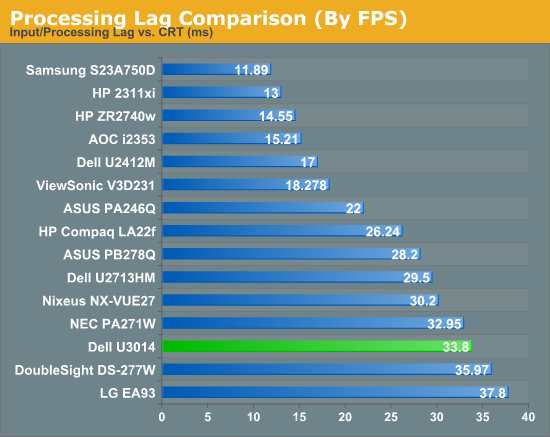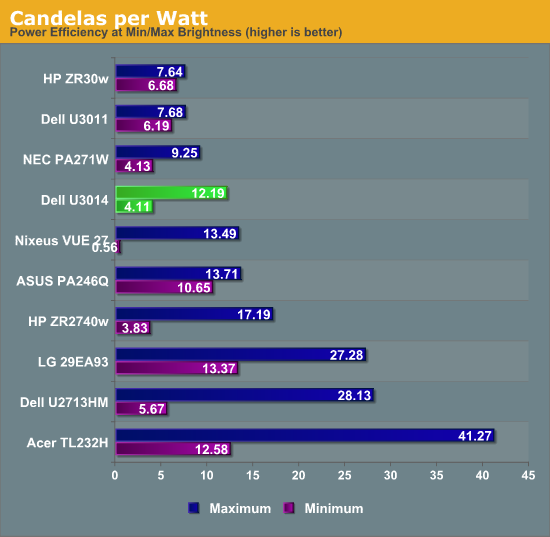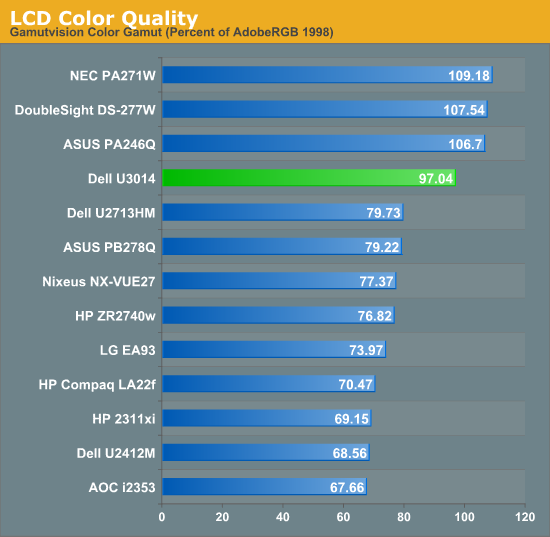Dell U3014 LCD Review
by Chris Heinonen on April 15, 2013 2:00 PM ESTUnfortunately, as I went to test this display using SMTT, which I’ve used for the past year, I found my license has expired. Furthermore, the author has stopped selling licenses right now, so we can’t use it anymore. This is unfortunate as it let us easily determine input lag versus pixel response time, and nothing else does that as well. With that gone, I went to three different options to test the lag on the Dell U3014:
- The Leo Bodnar Lag Tester
- FlatPanelsHD lag timer
- 3DMark03
Using the FlatPanelsHD test, it was a straight 49 or 50ms each time on the U3014. Since you have to mirror this on a CRT, that means running at 1920x1080 resolution on the Dell so the usual caveats apply, though it was the same lag with 1:1 pixel mapping or with scaling, so at least that introduces no additional penalty.
Using 3DMark03, I managed to measure right around 37.3ms, and with the Leo Bodnar lag tester I measured 33.8ms. All of these were while running in Game Mode, so the least input lag that I saw was two frames. Because I don’t live in a vacuum, I also looked at the results that TFT Central managed with the same display, since they have an oscilloscope that I don’t and they found virtually no lag at all. I think the 50ms number is really off, as there are issues with using a Flash timer for measuring lag. The Leo Bodnar actually gives three results, 28.4, 34, and 38.9, depending on if you are high, middle, or low on the screen, and so that low one more closely matches up with the 3DMark one, where the FPS counter is at the bottom.
Because of this, I think the Leo Bodnar average of the three is the most accurate number that I can produce right now. Of course, that is over HDMI and not DisplayPort or DVI, and at 1080p, so the reliability of that number is admittedly low, but there is no better solution available to me to measure it right now. I’d like to produce a better number than that, but sadly I can't at present. Hopefully SMTT will come back, as it produces a much better number with more verifiably accurate data, but right now I’m stuck with this method.

Power Use on the Dell is pretty good, considering the size of the panel. With an all-white screen at full backlight, it uses 77 watts of power. With the same screen and minimum backlight, it uses 33 watts of power. Given that 27” CCFL monitors can use well over 100 watts, to get this out of a 30” LCD is very good and a testament to the GB-LED backlighting system. To put this into a new way of measuring, at maximum backlight the U3014 produces 12.19 Candelas per Watt, and at minimum it produces 4.11 Candelas per Watt. I’ll try to use Candelas/Watt going forward, as it allows for uniform evaluations of power efficiency across all screen sizes. There are only a few monitors in here now, but I will try to go back and add more as I can.


We’ve already looked at Gamut a bit with the AdobeRGB charts, but I’m going to use the Gamutvision chart to see exactly how much of the AdobeRGB gamut is covered. According to its data, we see that 97% of the AdobeRGB gamut is accounted for. The Dell specs call for 99%, but with our slight under-saturation in red that probably accounts for the difference. It is still a very good number overall and should satisfy those that need the expanded gamut of AdobeRGB.












84 Comments
View All Comments
Kevin G - Tuesday, April 16, 2013 - link
I had to re-read the article to catch the few bits regarding MST support. I'm curious to see how well the MST hub works with a DP 1.1 monitor (more than likely) and a DP 1.1 output from a video card (not so likely). I was hoping for a bit more testing in this area but I guess you had to work with what you have on hand.Did you try any active DP-to-DVI adapters for usage with other displays?
Could you logically rotate the display connected via the MST out port independently of the primary?
Can the refresh rates on each monitor be adjust independently as well?
DigitalFreak - Monday, April 15, 2013 - link
RTFATrefugl - Monday, April 15, 2013 - link
You mention a 30" IPS display selling at Monoprice. Do you have plans to review, or can point me in the direction of one? I'm interested in a 30" display that is "decent" - I plan on using it for typical desktop use and gaming.Martin_Schou - Monday, April 15, 2013 - link
Does this monitor support USB over DisplayPort? I'm guessing it doesn't, and to be honest, I'm starting to be annoyed at having to pull an extra cable, that is frankly unneeded.cheinonen - Tuesday, April 16, 2013 - link
It doesn't seem to, no. When I unplugged the USB cable the USB devices stopped working, even though its connected over DisplayPort. A restart didn't fix this either.airmantharp - Monday, April 15, 2013 - link
TFT Central did an in-depth look into the input lag, and while they found similar numbers in the default modes, there is a 'gaming' mode that they measured at ~3ms. It appears to bypass all of the circuitry used for processing and scaling, and along with the new AG coating, makes this monitor preferable to HP's ZR30w for gaming.cheinonen - Monday, April 15, 2013 - link
I ran all the tests in the gaming mode, so that is where the numbers come from. So I don't know if the different methods account for everything, or if they might have gotten a different firmware, or something else.airmantharp - Monday, April 15, 2013 - link
I feel for you- trying to do an objective test without the equipment is challenging. I was just hoping to address some of the 'it's awful for gaming!' comments that ignored your mention of TFT Central's finding, especially as it's probably the best 30" for gaming.tocket - Monday, April 15, 2013 - link
What are the CIE standard observer color matching curves doing in the "spectral signature" chart? That is not very useful I think - it only makes it more confusing. I also want to comment that having "a much larger spectrum of light wavelengths" does not give you a larger gamut volume. If you want to get the largest possible gamut monochromatic light sources should be used (ideally at something like 450, 520 and 640 nm).cjl - Monday, April 15, 2013 - link
A quick comment - those touch sensitive buttons that you keep complaining about? Those aren't new. As a U3011 owner, I can tell you with some certainty that they've been there on Dell's flagship since at least the 3011. I haven't had any problems with mine either as far as responsiveness is concerned, but that may be personal preference (or maybe I happened to get a monitor with above-average responsiveness to the buttons).